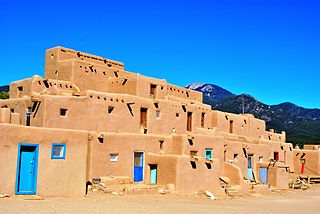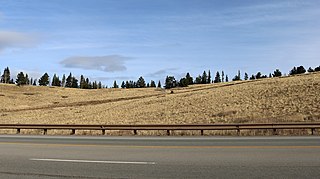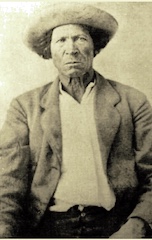
The Taos Mountain Trail was the historic pathway for trade and business exchanges between agrarian Taos (New Mexico) and the Great Plains (Colorado) from pre-history (1100 A.D.) through the Spanish Colonial period and into the time of the European and American presence. The Taos Mountain Trail, between northern New Mexico and southern Colorado, connected the high mountain traders and their trading partners north and south of the Sangre de Cristo Mountains. [1] Also called the Trapper's Trail, the pathway was only wide enough for people on foot or horses in single file, but it shortened a trip from Taos to the plains farther north from nearly two weeks to three days in good weather. The Taos Mountain Trail was also known as the Sangre de Cristo Trail and the Aztec Trail. [2]

Taos Pueblo is an ancient pueblo belonging to a Taos-speaking (Tiwa) Native American tribe of Puebloan people. It lies about 1 mile (1.6 km) north of the modern city of Taos, New Mexico. The pueblos are considered to be one of the oldest continuously inhabited communities in the United States. This has been designated a UNESCO World Heritage Site.

New Mexico is a state in the Southwestern region of the United States of America; its capital and cultural center is Santa Fe which was founded in 1610 as capital of Nuevo México, while its largest city is Albuquerque with its accompanying metropolitan area. It is one of the Mountain States and shares the Four Corners region with Utah, Colorado, and Arizona; its other neighboring states are Oklahoma to the northeast, Texas to the east-southeast, and the Mexican states of Chihuahua to the south and Sonora to the southwest. With a population around two million, New Mexico is the 36th state by population. With a total area of 121,590 sq mi (314,900 km2), it is the fifth-largest and sixth-least densely populated of the 50 states. Due to their geographic locations, northern and eastern New Mexico exhibit a colder, alpine climate, while western and southern New Mexico exhibit a warmer, arid climate.

The Great Plains is the broad expanse of flat land, much of it covered in prairie, steppe, and grassland, that lies west of the Mississippi River tallgrass prairie in the United States and east of the Rocky Mountains in the U.S. and Canada. It embraces:
Contents
In the early period (1100 AD to 1500 AD), the trail connected the Pueblos of northern New Mexico to the Plains Indians—Ute, Arapaho, Apache, Cheyenne and Kiowa. [3] The sedentary Pueblo people traded crops of corn, squash, melons, and beans to the migratory Plains tribes in exchange for buffalo meat, hides and other goods.

Ute people are Native Americans of the Ute tribe and culture and are among the Great Basin classification of Indigenous People. They have lived in the regions of present-day Utah and Colorado for centuries, hunting, fishing and gathering food. In addition to their home regions within Colorado and Utah, their hunting grounds extended into Wyoming, Oklahoma, and New Mexico. They had sacred grounds outside of their home domain that were also visited seasonally. Spiritual and ceremonial practices were observed by the Utes.

The Arapaho are a tribe of Native Americans historically living on the plains of Colorado and Wyoming. They were close allies of the Cheyenne tribe and loosely aligned with the Lakota and Dakota. The Arapaho language, Hinónoʼeitíít, is an Algonquian language closely related to Gros Ventre (Ahe/A'ananin), whose people are considered to have separated from the Arapaho at an early time. The Blackfeet and Cheyenne also speak Algonquian languages, but theirs are quite different from Arapaho.
The Apache are a group of culturally related Native American tribes in the Southwestern United States, which include the Chiricahua, Jicarilla, Lipan, Mescalero, Salinero, Plains and Western Apache. Distant cousins of the Apache are the Navajo, with which they share the Southern Athabaskan languages. There are Apache communities in Oklahoma, Texas, and reservations in Arizona and New Mexico. Apache people have moved throughout the United States and elsewhere, including urban centers. The Apache Nations are politically autonomous, speak several different languages and have distinct cultures.
 |
| Trails |
|---|
Legend has it that traders from far away Tenochtitlan, the Aztec capital (near modern Mexico City) used the trail leaving cairns of stones to mark the way. Although there is a great deal of evidence that the people of MesoAmerica traded North into present day Colorado (Mesa Verde), [4] the only evidence for Tarahumaran penetration into Colorado was the discovery of plant of Mexican origin at the top of the pass by William A. Weber, professor emeritus of Botany. Charlie Charlefue, a Huerfano Valley resident, also placed a group of Tarahumara Indians in the area prior to American contact [5]

Tenochtitlan was a large Mexica city-state in what is now the center of Mexico City. Founded on June 20, 1325, the city was built on an island in what was then Lake Texcoco in the Valley of Mexico. The city was the capital of the expanding Aztec Empire in the 15th century until it was captured by the Spanish in 1521.

Mexico City, or the City of Mexico, is the capital of Mexico and the most populous city in North America. Mexico City is one of the most important cultural and financial centres in the Americas. It is located in the Valley of Mexico, a large valley in the high plateaus in the center of Mexico, at an altitude of 2,240 meters (7,350 ft). The city has 16 boroughs.
Taos Pueblo was a trading center hosting fall and spring trade fairs. [6] This fair is mentioned as being in existence prior to and throughout the Spanish Colonial period. In good weather, the Taos Mountain Trail provided the pathway for travel from the eastern plains to the wide plateaus of the Taos Pueblo.
Trading companies (desiring furs and hides) determined that sending out men to trade with the Native American groups for the desired hides was more efficient than building trading posts and inviting the Native American people to visit. [7] The traders would obtain their goods from stores in Taos or Santa Fe then return to sell the hides obtained in trade with the Native American thus making the Taos Mountain Trail conduit more important. To aid the trade, Bent's Fort was built in 1833 [8] and El Pueblo Trading Post followed in 1842. [9] Traders headquartered in Bent's Fort and El Pueblo went out to trade with goods from Taos. The Taos Mountain Trail continued in use as it provided quick access to a settled community.
During the Mexican-American War, the people of Taos (Taoseños), both Native American and Spanish, revolted in January 1847 killing many Americans living in Taos including the American appointed governor Charles Bent. Survivors of the attack at nearby Turley’s Mill crossed the Taos Mountain Trail on foot in winter to spread the word of the revolt to El Pueblo Trading Post and Bent’s Fort. [10]

The indigenous peoples of the Americas are the Pre-Columbian peoples of North, Central and South America and their descendants.

Charles Bent was appointed as the first civilian Governor of the newly acquired New Mexico Territory by military Governor Stephen Watts Kearny in September 1846.
During the railroad expansion era (1848-1853), the Taos Mountain Trail, also called the Sangre de Cristo Pass, was considered for a railway route. E.G. Beckwith was sent to survey the area in 1853. Richard Kern, a topographer and expeditionary artist, traveled with Beckwith to illustrate the land for the report. Although the trail was not chosen for the railroad as it was too steep, the report did provide documentation of the Taos Mountain Trail. [11]







